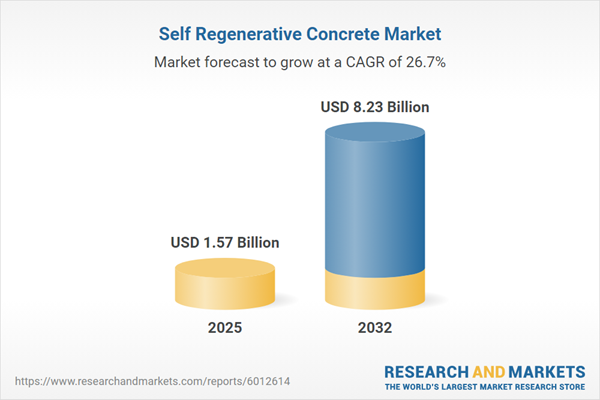Speak directly to the analyst to clarify any post sales queries you may have.
Self regenerating concrete represents a transformative advancement in construction materials, empowering infrastructure leaders to proactively address evolving durability requirements and sustainability objectives. As organizations refine asset strategies to balance long-term cost control and environmental performance, self regenerating concrete stands out as a strategic solution supporting resilient, future-ready development.
Market Snapshot: Self Regenerating Concrete Market
The global self regenerating concrete market advanced from USD 1.24 billion in 2024 to USD 1.57 billion in 2025, achieving a strong CAGR of 26.66%, and is set to reach USD 8.23 billion by 2032.
This robust expansion is driven by rapid adoption in sectors demanding stronger, longer-lasting infrastructure and heightened adherence to sustainable construction standards. Uptake intensifies as public and private initiatives focus on greenfield projects, urban revitalization, and the integration of environmental compliance into capital investments. Organizations across regions are turning to self regenerating concrete to align with policy mandates, streamline operations, and maximize asset longevity within dynamic regulations.Scope & Segmentation of the Self Regenerating Concrete Market
This analysis provides a focused segmentation for senior executives, project leads, and capital investment teams navigating operational, regulatory, and risk complexities surrounding self regenerating concrete adoption. The segmentation addresses emerging infrastructure trends and the deployment of advanced restorative technologies.
- Technology: Incorporates biomineralization systems, encapsulated bacteria, polymer-enhanced matrices, and nanotechnology—each designed to automatically repair microcracks and extend the usable life of concrete structures.
- Bacterial Types: Encompasses ureolytic and non ureolytic strains, enabling flexible deployment in diverse environments and climate zones to achieve reliable in-situ crack healing.
- Encapsulation Methods: Utilizes ceramic, polymer, and silica gel matrices to protect bacterial viability throughout mixing, pouring, and the operational lifespan of concrete infrastructure.
- Nanomaterials: Integration of carbon nanotubes, nano silica, and nano titanium dioxide to boost structural reinforcement and restorative capacity in demanding applications.
- Polymer Options: Includes epoxy polymer, polyethylene glycol, and polyvinyl alcohol, providing tailored mechanical properties and lifecycle performance suited to varying project specifications.
- Applications: Targeted at commercial, industrial, marine, transportation, and residential infrastructure, spanning both new construction and asset rehabilitation.
- End Use: Suited for new builds, retrofits, and specialized maintenance programs to ensure project adaptability and extend asset serviceability.
- Form Factors: Available in cast in place, shotcrete, precast block, panel, and pipe forms to efficiently support a range of construction scenarios.
- Distribution Channels: Covers direct sales, manufacturer representatives, distributorships, dealer networks, and digital procurement to optimize sourcing strategies for enterprise buyers.
- Regions: The Americas, Europe, Middle East & Africa, and Asia-Pacific each offer unique regulatory challenges and adoption trends, shaping local market demand and the pace of innovation.
- Company Profiles: Features industry leaders such as Basilisk Self-Healing Concrete B.V., HeidelbergCement AG, Holcim Ltd, Sika AG, BASF SE, MAPEI S.p.A., CEMEX S.A.B. de C.V., GCP Applied Technologies Inc., Xypex Chemical Corporation, and Buzzi Unicem S.p.A.
Key Takeaways for Senior Decision-Makers
- Self regenerating concrete effectively reduces the need for routine maintenance, simplifying lifecycle asset management for portfolio owners and operations managers.
- Technology platforms offer flexibility for compliance, allowing projects to meet changing local and international regulatory frameworks.
- Recent advancements in material science foster better regulatory alignment and enable forward-thinking, sustainable capital allocation strategies.
- Distinct regional adoption patterns reflect priorities: EMEA emphasizes climate adaptation, while Asia-Pacific and the Americas concentrate on infrastructure modernization and expansion.
- Collaboration with innovative suppliers strengthens supply chain reliability and ensures procurement strategies remain flexible amid evolving industry standards.
- Leveraging performance analytics for predictive maintenance enhances reliability, supporting competitive bids and stringent service level agreements.
Tariff Impact on Self Regenerating Concrete Supply Chains
Anticipated US tariffs in 2025 will influence the sourcing of encapsulation polymers and nano additives within the self regenerating concrete supply ecosystem. Manufacturers are proactively fortifying regional supply bases and establishing strategic partnerships to uphold quality benchmarks and minimize exposure to global disruptions. These adaptive measures help project teams maintain delivery timelines and stabilize procurement costs in a volatile trade environment.
Methodology & Data Sources
This research synthesizes executive interviews, proprietary industry data, and comprehensive on-site analyses. Validation includes peer-reviewed literature, patent analysis, and quantitative supply chain assessments to inform decision-makers with reliable, actionable insights.
Why This Report Matters
- Enables senior leaders to make well-supported infrastructure procurement and investment decisions through adaptable and data-driven market intelligence.
- Clarifies region-specific opportunities and risks, informing practical action plans for market entry, partnership, and portfolio expansion.
- Facilitates alignment between sustainability targets, innovation priorities, and organizational growth strategies, supporting long-term operational continuity.
Conclusion
Self regenerating concrete is advancing industry standards for material resilience and sustainability in infrastructure. Ongoing development and robust supplier relationships remain essential for supporting optimized capital planning and consistent value delivery across all project types.
Additional Product Information:
- Purchase of this report includes 1 year online access with quarterly updates.
- This report can be updated on request. Please contact our Customer Experience team using the Ask a Question widget on our website.
Table of Contents
3. Executive Summary
4. Market Overview
7. Cumulative Impact of Artificial Intelligence 2025
Companies Mentioned
The companies profiled in this Self Regenerative Concrete market report include:- Basilisk Self-Healing Concrete B.V.
- HeidelbergCement AG
- Holcim Ltd
- Sika AG
- BASF SE
- MAPEI S.p.A.
- CEMEX S.A.B. de C.V.
- GCP Applied Technologies Inc.
- Xypex Chemical Corporation
- Buzzi Unicem S.p.A.
Table Information
| Report Attribute | Details |
|---|---|
| No. of Pages | 186 |
| Published | November 2025 |
| Forecast Period | 2025 - 2032 |
| Estimated Market Value ( USD | $ 1.57 Billion |
| Forecasted Market Value ( USD | $ 8.23 Billion |
| Compound Annual Growth Rate | 26.6% |
| Regions Covered | Global |
| No. of Companies Mentioned | 11 |









